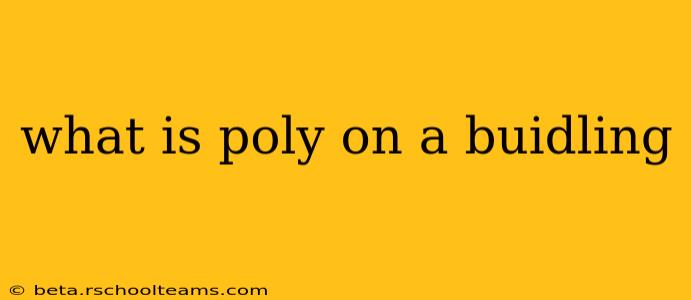The term "poly" on a building usually refers to polycarbonate, a strong, lightweight, and versatile thermoplastic polymer frequently used in construction for roofing and cladding. It's not a single, monolithic material, but rather encompasses a range of products with different properties, depending on the application and manufacturing process. Let's delve deeper into this popular building material and address some common questions.
What are the different types of Polycarbonate used in construction?
Polycarbonate comes in several forms, each suited for different building applications:
-
Solid Polycarbonate Sheets: These are the most common type, offering excellent impact resistance and light transmission. They're often used for roofing, skylights, and canopies, where strength and durability are crucial. They come in various thicknesses and colours.
-
Multiwall Polycarbonate Sheets: These sheets feature multiple layers separated by air spaces, providing even greater insulation properties than solid sheets. This makes them ideal for applications where energy efficiency is paramount, such as greenhouses, conservatories, and insulated roofing systems. They often have a honeycomb or corrugated structure.
-
Polycarbonate Panels: Larger, pre-fabricated panels, often incorporating reinforced framing or other structural elements, provide ready-to-install solutions for walls and roofing. These are commonly used in modern architectural designs.
What are the benefits of using Polycarbonate in construction?
The popularity of polycarbonate in construction stems from its numerous advantages:
-
High Impact Resistance: Polycarbonate is significantly stronger than glass and acrylic, making it ideal for areas prone to impacts or vandalism.
-
Lightweight: Its lighter weight compared to glass simplifies installation and reduces structural demands on the building.
-
Excellent Light Transmission: Polycarbonate sheets allow ample natural light to penetrate the building, reducing the need for artificial lighting and enhancing the interior environment.
-
UV Protection: Many polycarbonate sheets incorporate UV protection to prevent degradation from prolonged sun exposure, ensuring longevity.
-
Flexibility and Design Options: Polycarbonate can be curved and shaped to create aesthetically pleasing and functional designs, accommodating various architectural styles.
-
Thermal Insulation (Multiwall): Multiwall polycarbonate offers superior insulation, reducing energy costs for heating and cooling.
What are the drawbacks of using Polycarbonate?
While offering many advantages, polycarbonate also has some limitations:
-
Scratch Sensitivity: Polycarbonate sheets can be susceptible to scratching, particularly during installation and handling. Proper care and handling are essential.
-
Expansion and Contraction: Like other plastics, polycarbonate can expand and contract with temperature changes. Proper installation techniques are crucial to avoid problems.
-
Cost: Polycarbonate is generally more expensive than other roofing or cladding materials like glass or metal sheeting.
-
UV Degradation (unprotected): While many polycarbonate sheets offer UV protection, those without can degrade over time in direct sunlight.
How is Polycarbonate installed on a building?
The installation method varies depending on the type of polycarbonate sheet and the specific building application. Generally, it involves using appropriate fasteners and sealing materials to ensure watertightness and structural integrity. Professional installation is recommended, especially for large projects.
Is Polycarbonate suitable for all building applications?
Polycarbonate is a versatile material, but its suitability depends on specific project requirements. Factors to consider include budget, climate, structural considerations, aesthetic preferences, and the required level of light transmission and insulation. A consultation with a qualified building professional is recommended to determine the optimal material choice.
This comprehensive overview should help you understand the multifaceted nature of "poly" in the context of building construction. Remember to always consult with experienced professionals for proper selection, design, and installation to ensure the longevity and safety of your project.
